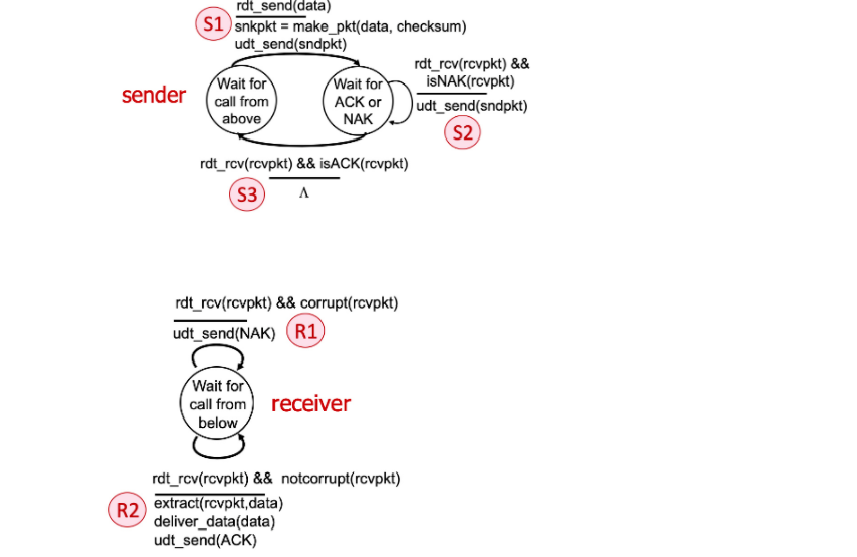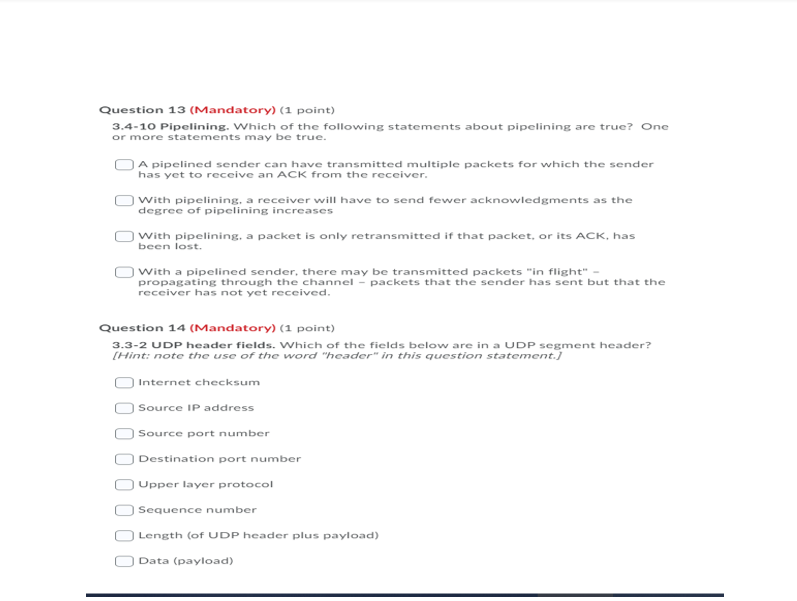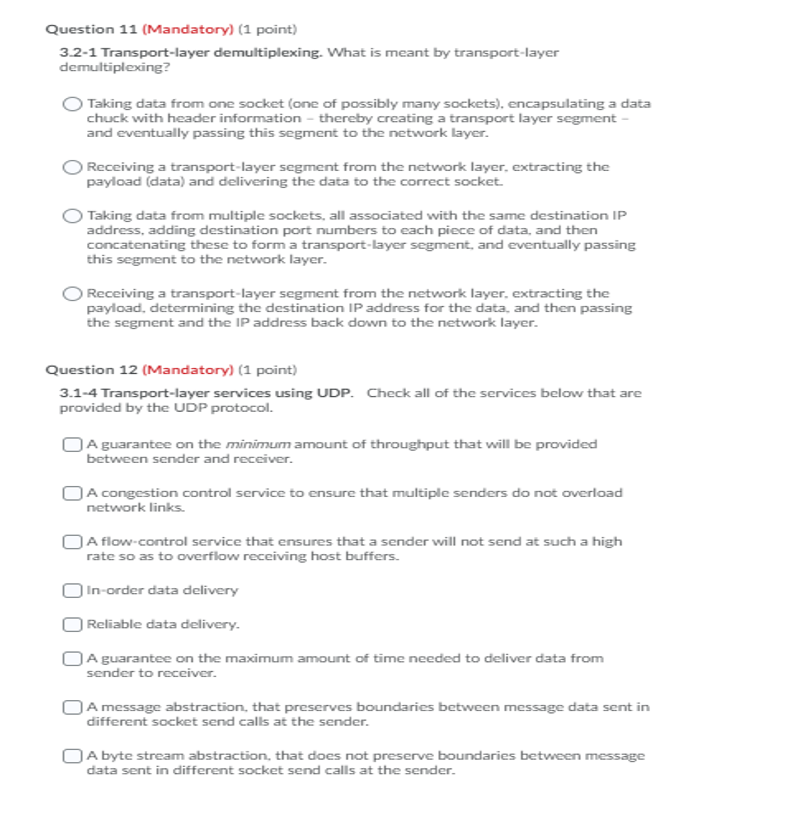Question 9 (Mandatory) (1 point)
3.4-2 The rdt 2.0 protocol. Consider the rdt 2.0 sender and receiver shown below, with FSM transitions at the sender labeled S1, S2, and S3; and receiver transitions labeled R1 and R2. Which of the following sequences of transitions could possibly occur as a result of an initial rdt_send() call at the sender, and possible later message corruption and subsequent error recovery
 Question 9 options:
Question 9 options:
a)S1,R2,S3
b)S1,R2,S2
d)S1,S2,S3
e)S1,R1,S3
f)S1,R1,S2,R2,S3
g)S1,R1,S2,R1,S3
3.3-1 Does UDP preserve application-layer message boundaries? True or False: On the sending side, the UDP sender will take each application-layer chunk of data written into a UDP socket and send it in a distinct UDP datagram. And then on the receiving side, UDP will deliver a segment's payload into the appropriate socket, preserving the application-defined message boundary.Question 10 (Mandatory) (1 point)
a)true
b)false


sender rdt_send(data) S1 snkpkt = make_pkt(data, checksum) udt_send(sndpkt) rdt_rcv(rcvpkt) && Wait for Wait for iSNAK(rcvpkt) call from ACK or udt_send(sndpkt) above NAK S2 rdt_rcv(rcvpkt) && isACK(revpkt) S3 A rdt_rcv(rcvpkt) && corrupt(rcvpkt) udt_send(NAK) R1 Wait for call from receiver below rdt_rcv(rcvpkt) && notcorrupt(rcvpkt) R2 extract(rcvpkt, data) deliver_data(data) udt_send(ACK) Question 13 (Mandatory) (1 point) 3.4-10 Pipelining. Which of the following statements about pipelining are true? One or more statements may be true. A pipelined sender can have transmitted multiple packets for which the sender has yet to receive an ACK from the receiver. With pipelining, a receiver will have to send fewer acknowledgments as the degree of pipelining increases With pipelining, a packet is only retransmitted if that packet, or its ACK, has been lost. With a pipelined sender, there may be transmitted packets "in flight" propagating through the channel - packets that the sender has sent but that the receiver has not yet received. Question 14 (Mandatory) (1 point) 3.3-2 UDP header fields. Which of the fields below are in a UDP segment header? (Hint: note the use of the word "header" in this question statement.) Internet checksum Source IP address Source port number Destination port number Upper layer protocol Sequence number Length (of UDP header plus payload) Data (payload) Question 11 (Mandatory) (1 point) 3-2-1 Transport-layer demultiplexing. What is meant by transport-layer demultiplexing? Taking data from one socket (one of possibly many sockets), encapsulating a data chuck with header information - thereby creating a transport layer segment - and eventually passing this segment to the network layer. Receiving a transport-layer segment from the network layer, extracting the payload (data) and delivering the data to the correct socket Taking data from multiple sockets, all associated with the same destination IP address, adding destination port numbers to each piece of data, and then concatenating these to form a transport-layer segment, and eventually passing this segment to the network layer. Receiving a transport-layer segment from the network layer, extracting the payload, determining the destination IP address for the data and then passing the segment and the IP address back down to the network layer. Question 12 (Mandatory) (1 point) 3.1-4 Transport-layer services using UDP. Check all of the services below that are provided by the UDP protocol. Aguarantee on the minimum amount of throughput that will be provided between sender and receiver. A congestion control service to ensure that multiple senders do not overload network links. A flow-control service that ensures that a sender will not send at such a high rate so as to overflow receiving host buffers. In-order data delivery Reliable data delivery. Aguarantee on the maximum amount of time needed to deliver data from sender to receiver. A message abstraction, that preserves boundaries between message data sent in different socket send calls at the sender. A byte stream abstraction, that does not preserve boundaries between message data sent in different socket send calls at the sender
 Question 9 options:
Question 9 options:







